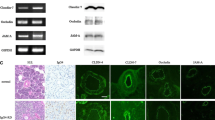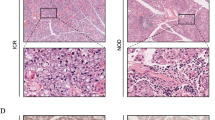Abstract
IgG4-related sialadenitis (IgG4-RS) is a chronic fibro-inflammatory disease characterized by swelling of salivary glands and varying degrees of xerostomia. Tight junctions (TJs) play an essential role in maintaining secretory function by regulating the paracellular flow of ions and water. However, whether TJs are altered and contribute to the hyposecretion in IgG4-RS is not fully understood. Here, a total of 399 differentially expressed proteins were identified in IgG4-RS submandibular glands (SMGs) and enriched in the regulation of actin cytoskeleton and the salivary secretion. Real-time PCR results showed that the mRNA levels of claudin-3, -4, -6, -7, -8, -10, -12, occludin, and ZO-1 were significantly lower, whereas claudin-1 and -5 were higher in IgG4-RS SMGs. Immunohistochemical and immunofluorescence staining revealed that claudin-1, -3, -4, occludin, and ZO-1 were mainly distributed at apicolateral membranes in acini and ducts of SMGs from controls, whereas claudin-1 protein intensity at apicolateral membrane was elevated, while the staining of claudin-3, -4, and ZO-1 were reduced in IgG4-RS SMGs. Occludin was dispersed into cytoplasm of acini and ducts in SMGs of patients. Among them, claudin-3 and ZO-1 protein levels were positively correlated with saliva flow rate. Furthermore, the decreased fluorescence intensity of F-actin at peri-apicolateral membranes and the loss of ZO-1 staining at the same location were observed in acinar and ductal cells of IgG4-RS SMGs, which might be responsible for disorganization of TJ complex. Taken together, these findings indicate that the integrity of TJ complex of SMGs is impaired and might contribute to hyposalivation of IgG4-RS patients.









Similar content being viewed by others
References
Abe A, Takano K, Kojima T, Nomura K, Kakuki T, Kaneko Y, Yamamoto M, Takahashi H, Himi T (2016) Interferon-gamma increased epithelial barrier function via upregulating claudin-7 expression in human submandibular gland duct epithelium. J Mol Histol 47:353–363. https://doi.org/10.1007/s10735-016-9667-2
Ahmad R, Kumar B, Chen Z et al (2017) Loss of claudin-3 expression induces IL6/gp130/Stat3 signaling to promote colon cancer malignancy by hyperactivating Wnt/β-catenin signaling. Oncogene 36:6592–6604. https://doi.org/10.1038/onc.2017.259
Baker OJ (2016) Current trends in salivary gland tight junctions. Tissue Barriers 4:e1162348. https://doi.org/10.1080/21688370.2016.1162348
Baker OJ, Camden JM, Redman RS, Jones JE, Seye CI, Erb L, Weisman GA (2008) Proinflammatory cytokines tumor necrosis factor-alpha and interferon-gamma alter tight junction structure and function in the rat parotid gland Par-C10 cell line. Am J Physiol Cell Physiol 295:C1191–C1201. https://doi.org/10.1152/ajpcell.00144.2008
Barrera MJ, Bahamondes V, Sepúlveda D et al (2013) Sjogren's syndrome and the epithelial target: a comprehensive review. J Autoimmun 42:7–18. https://doi.org/10.1016/j.jaut.2013.02.001
Basler K, Brandner JM (2017) Tight junctions in skin inflammation. Pflugers Arch 469:3–14. https://doi.org/10.1007/s00424-016-1903-9
Brito-Zeron P, Ramos-Casals M, Bosch X, Stone JH (2014) The clinical spectrum of IgG4-related disease. Autoimmun Rev 13:1203–1210. https://doi.org/10.1016/j.autrev.2014.08.013
Buckley A, Turner JR (2018) Cell biology of tight junction barrier regulation and mucosal disease. Cold Spring Harb Perspect Biol 10:a029314. https://doi.org/10.1101/cshperspect.a029314
Cong X, Zhang Y, Yang NY et al (2013) Occludin is required for TRPV1-modulated paracellular permeability in the submandibular gland. J Cell Sci 126:1109–1121. https://doi.org/10.1242/jcs.111781
Cong X, Zhang Y, Li J et al (2015) Claudin-4 is required for modulation of paracellular permeability by muscarinic acetylcholine receptor in epithelial cells. J Cell Sci 128:2271–2286. https://doi.org/10.1242/jcs.165878
Ding C, Zhang Y, Peng X et al (2011) Proteomic analysis of human transplanted submandibular gland in patients with epiphora after transplantation. J Proteome Res 10:2206–2215. https://doi.org/10.1021/pr100965q
Ding C, Cong X, Zhang XM, Li SL, Wu LL, Yu GY (2017) Decreased interaction between ZO-1 and occludin is involved in alteration of tight junctions in transplanted epiphora submandibular glands. J Mol Histol 48:225–234. https://doi.org/10.1007/s10735-017-9716-5
Ewert P, Aguilera S, Alliende C et al (2010) Disruption of tight junction structure in salivary glands from Sjogren's syndrome patients is linked to proinflammatory cytokine exposure. Arthritis Rheum 62:1280–1289. https://doi.org/10.1002/art.27362
Forster C (2008) Tight junctions and the modulation of barrier function in disease. Histochem Cell Biol 130:55–70. https://doi.org/10.1007/s00418-008-0424-9
Fromm M, Piontek J, Rosenthal R, Gunzel D, Krug SM (2017) Tight junctions of the proximal tubule and their channel proteins. Pflugers Arch 469:877–887. https://doi.org/10.1007/s00424-017-2001-3
Fujimoto K, Kinoshita M, Tanaka H et al (2017) Regulation of intestinal homeostasis by the ulcerative colitis-associated gene RNF186. Mucosal Immunol 10:446–459. https://doi.org/10.1038/mi.2016.58
Garcia-Hernandez V, Quiros M, Nusrat A (2017) Intestinal epithelial claudins: expression and regulation in homeostasis and inflammation. Ann N Y Acad Sci 1397:66–79. https://doi.org/10.1111/nyas.13360
Hong X, Min SN, Zhang YY, Lin YT, Wang F, Huang Y, Yu GY, Wu LL, Yang HY (2019) TNF-α suppresses autophagic flux in acinar cells in IgG4-related sialadenitis. J Dent Res 98:1386–1396. https://doi.org/10.1177/0022034519871890
Huang N, Zhang X, Jiang Y, Mei H, Zhang L, Zhang Q, Hu J, Chen B (2019) Increased levels of serum pigment epithelium-derived factor aggravate proteinuria via induction of podocyte actin rearrangement. Int Urol Nephrol 51:359–367. https://doi.org/10.1007/s11255-018-2026-3
Kawa S, Skold M, Ramsden DB, Parker A, Harding SJ (2017) Serum IgG4 concentration in IgG4-related disease. Clin Lab 63:1323–1337. https://doi.org/10.7754/Clin.Lab.2017.170403
Krug SM, Schulzke JD, Fromm M (2014) Tight junction, selective permeability, and related diseases. Semin Cell Dev Biol 36:166–176. https://doi.org/10.1016/j.semcdb.2014.09.002
Li J, Cong X, Zhang Y et al (2015a) ZO-1 and -2 are required for TRPV1-modulated paracellular permeability. J Dent Res 94:1748–1756. https://doi.org/10.1177/0022034515609268
Li W, Chen Y, Sun ZP et al (2015b) Clinicopathological characteristics of immunoglobulin G4-related sialadenitis. Arthritis Res Ther 17:186. https://doi.org/10.1186/s13075-015-0698-y
Liu Y, Xue M, Wang Z et al (2019) Salivary gland involvement disparities in clinical characteristics of IgG4-related disease: a retrospective study of 428 patients. Rheumatology (Oxford). https://doi.org/10.1093/rheumatology/kez280
Maehara T, Mattoo H, Ohta M et al (2017) Lesional CD4+ IFN-γ+ cytotoxic T lymphocytes in IgG4-related dacryoadenitis and sialoadenitis. Ann Rheum Dis 76:377–385. https://doi.org/10.1136/annrheumdis-2016-209139
Mei M, Xiang RL, Cong X et al (2015) Claudin-3 is required for modulation of paracellular permeability by TNF-α through ERK1/2/slug signaling axis in submandibular gland. Cell Signal 27:1915–1927. https://doi.org/10.1016/j.cellsig.2015.07.002
Moriyama M, Tanaka A, Maehara T et al (2013) Clinical characteristics of Mikulicz's disease as an IgG4-related disease. Clin Oral Investig 17:1995–2002. https://doi.org/10.1007/s00784-012-0905-z
Muller T, Beutler C, Pico AH et al (2013) Increased T-helper 2 cytokines in bile from patients with IgG4-related cholangitis disrupt the tight junction-associated biliary epithelial cell barrier. Gastroenterology 144:1116–1128. https://doi.org/10.1053/j.gastro.2013.01.055
Nam K, Maruyama CL, Trump BG, Buchmann L, Hunt JP, Monroe MM, Baker OJ (2016) Post-irradiated human submandibular glands display high collagen deposition, disorganized cell junctions, and an increased number of adipocytes. J Histochem Cytochem 64:343–352. https://doi.org/10.1369/0022155416646089
Odenwald MA, Choi W, Buckley A et al (2017) ZO-1 interactions with F-actin and occludin direct epithelial polarization and single lumen specification in 3D culture. J Cell Sci 130:243–259. https://doi.org/10.1242/jcs.188185
Ohira M, Oshitani N, Hosomi S et al (2009) Dislocation of Rab13 and vasodilator-stimulated phosphoprotein in inactive colon epithelium in patients with Crohn's disease. Int J Mol Med 24:829–835. https://doi.org/10.3892/ijmm_00000300
Ohta N, Makihara S, Okano M et al (2012) Roles of IL-17, Th1, and Tc1 cells in patients with IgG4-related sclerosing sialadenitis. Laryngoscope 122:2169–2174. https://doi.org/10.1002/lary.23429
Poritz LS, Garver KI, Green C, Fitzpatrick L, Ruggiero F, Koltun WA (2007) Loss of the tight junction protein ZO-1 in dextran sulfate sodium induced colitis. J Surg Res 140:12–19. https://doi.org/10.1016/j.jss.2006.07.050
Reinhold AK, Rittner HL (2017) Barrier function in the peripheral and central nervous system-a review. Pflugers Arch 469:123–134. https://doi.org/10.1007/s00424-016-1920-8
Shen L, Black ED, Witkowski ED, Lencer WI, Guerriero V, Schneeberger EE, Turner JR (2006) Myosin light chain phosphorylation regulates barrier function by remodeling tight junction structure. J Cell Sci 119:2095–2106. https://doi.org/10.1242/jcs.02915
Shimizu Y, Yamamoto M, Naishiro Y et al (2013) Necessity of early intervention for IgG4-related disease-delayed treatment induces fibrosis progression. Rheumatology (Oxford) 52:679–683. https://doi.org/10.1093/rheumatology/kes358
Soliotis F, Mavragani CP, Plastiras SC, Rontogianni D, Skopouli FN, Moutsopoulos HM (2014) IgG4-related disease: a rheumatologist's perspective. Clin Exp Rheumatol 32:724–727
Stone JH, Zen Y, Deshpande V (2012) IgG4-related disease. N Engl J Med 366:539–551. https://doi.org/10.1056/NEJMra1104650
Takeuchi M, Sato Y, Ohno K et al (2014) T helper 2 and regulatory T-cell cytokine production by mast cells: a key factor in the pathogenesis of IgG4-related disease. Mod Pathol 27:1126–1136. https://doi.org/10.1038/modpathol.2013.236
Thewissen M, Somers V, Hellings N, Fraussen J, Damoiseaux J, Stinissen P (2007) CD4+CD28null T cells in autoimmune disease: pathogenic features and decreased susceptibility to immunoregulation. J Immunol 179:6514–6523. https://doi.org/10.4049/jimmunol.179.10.6514
Umehara H, Okazaki K, Masaki Y et al (2012) Comprehensive diagnostic criteria for IgG4-related disease (IgG4-RD), 2011. Mod Rheumatol 22:21–30. https://doi.org/10.1007/s10165-011-0571-z
Umehara H, Nakajima A, Nakamura T, Kawanami T, Tanaka M, Dong L, Kawano M (2014) IgG4-related disease and its pathogenesis-cross-talk between innate and acquired immunity. Int Immunol 26:585–595. https://doi.org/10.1093/intimm/dxu074
Wang Z, Shen MM, Liu XJ, Si Y, Yu GY (2015) Characteristics of the saliva flow rates of minor salivary glands in healthy people. Arch Oral Biol 60:385–392. https://doi.org/10.1016/j.archoralbio.2014.11.016
Wei SC, Yang-Yen HF, Tsao PN et al (2017) SHANK3 regulates intestinal barrier function through modulating ZO-1 expression through the PKCε-dependent pathway. Inflamm Bowel Dis 23:1730–1740. https://doi.org/10.1097/mib.0000000000001250
Xu J, Liang R, Zhang W, Tian K, Li J, Chen X, Tao Y, Chen Q (2019) Faecalibacterium prausnitzii-derived Microbial Anti-inflammatory Molecule regulates intestinal integrity in diabetes mellitus mice via modulating tight junction protein expression. J Diabetes. https://doi.org/10.1111/1753-0407.12986
Yamamoto M, Tabeya T, Naishiro Y et al (2012) Value of serum IgG4 in the diagnosis of IgG4-related disease and in differentiation from rheumatic diseases and other diseases. Mod Rheumatol 22:419–425. https://doi.org/10.1007/s10165-011-0532-6
Yang NY, Ding C, Li J, Zhang Y, Xiang RL, Wu LL, Yu GY, Cong X (2017) Muscarinic acetylcholine receptor-mediated tight junction opening is involved in epiphora in late phase of submandibular gland transplantation. J Mol Histol 48:99–111. https://doi.org/10.1007/s10735-016-9709-9
Zhang GH, Wu LL, Yu GY (2013) Tight junctions and paracellular fluid and ion transport in salivary glands. Chin J Dent Res 16:13–46
Zhang LW, Cong X, Zhang Y et al (2016) Interleukin-17 impairs salivary tight junction integrity in Sjogren's syndrome. J Dent Res 95:784–792. https://doi.org/10.1177/0022034516634647
Zhang XM, Huang Y, Zhang K, Qu LH, Cong X, Su JZ, Wu LL, Yu GY, Zhang Y (2018) Expression patterns of tight junction proteins in porcine major salivary glands: a comparison study with human and murine glands. J Anat 233:167–176. https://doi.org/10.1111/joa.12833
Acknowledgements
This work was funded by the National Natural Science Foundation of China 81671005 (GYY), 81974151 (GYY), and 81771093 (XC).
Author information
Authors and Affiliations
Contributions
SNM performed the major experiments and wrote the manuscript. YYZ and WXZ were responsible for the collection of clinical data. LLW participated in data interpretation and wrote the manuscript. XC and GYY designed the study, analyzed the data, and wrote the manuscript. All authors read and approved the final manuscript.
Corresponding authors
Ethics declarations
Conflict of interest
The authors have no conflicts of interest to disclose.
Additional information
Publisher's Note
Springer Nature remains neutral with regard to jurisdictional claims in published maps and institutional affiliations.
Rights and permissions
About this article
Cite this article
Min, SN., Wu, LL., Zhang, YY. et al. Disruption of tight junction structure contributes to secretory dysfunction in IgG4-related sialadenitis. J Mol Hist 51, 33–46 (2020). https://doi.org/10.1007/s10735-019-09854-8
Received:
Accepted:
Published:
Issue Date:
DOI: https://doi.org/10.1007/s10735-019-09854-8




